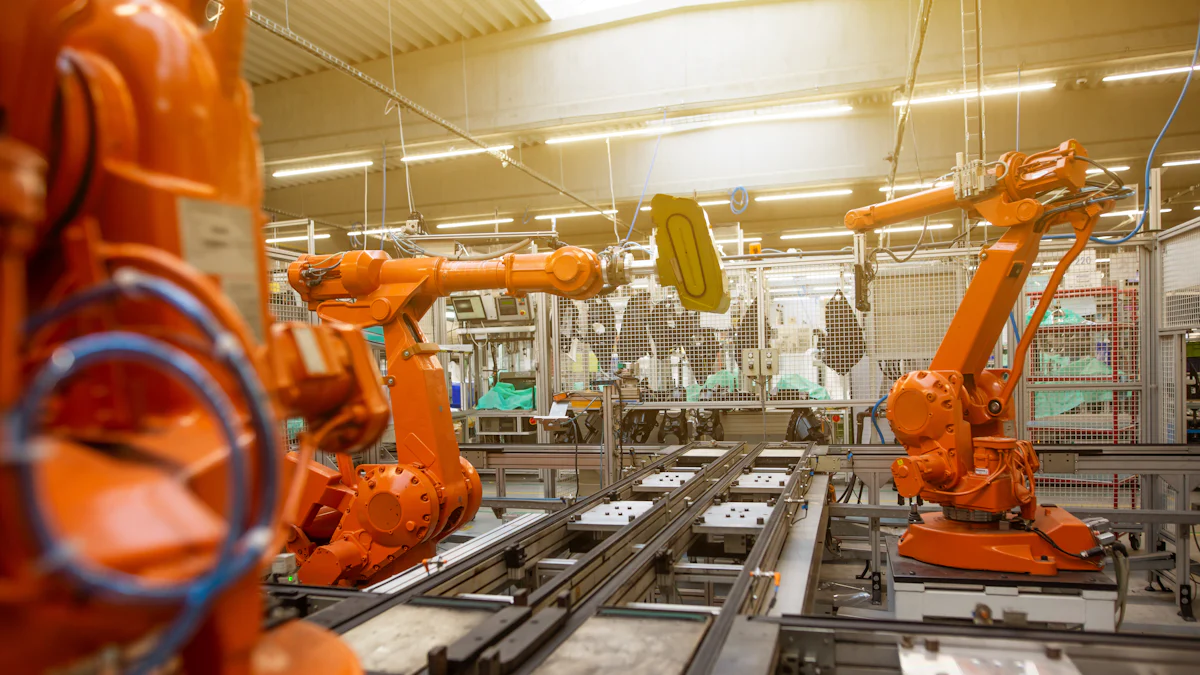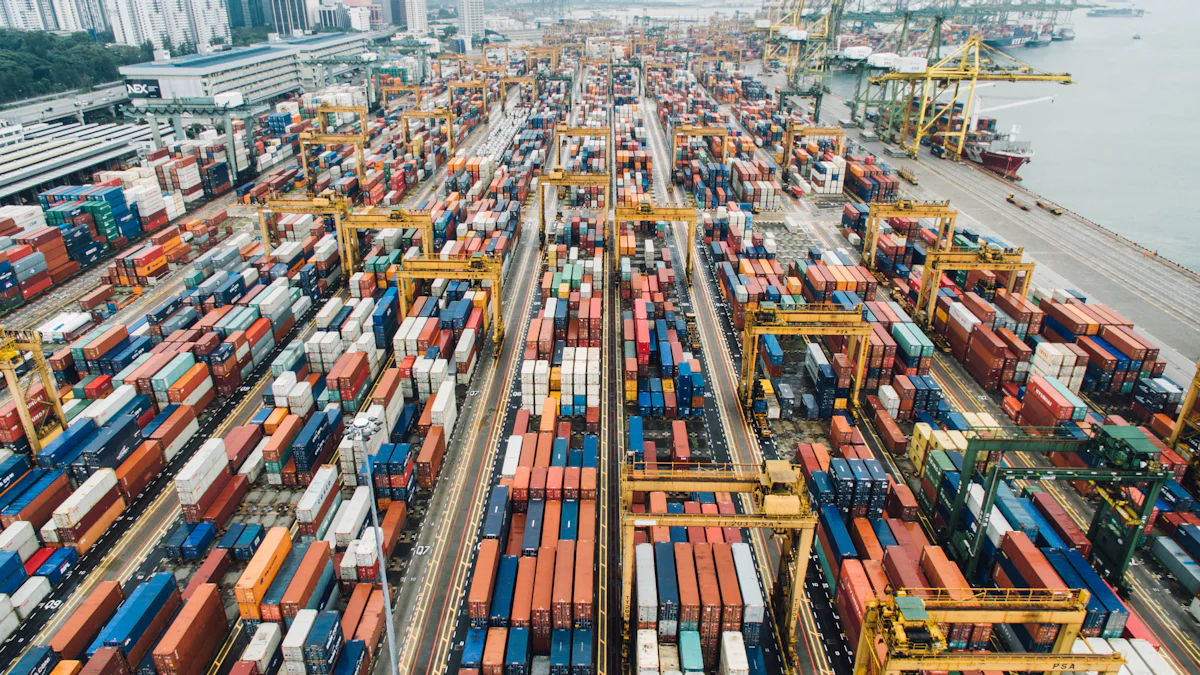The Path to 2030: AI and Robotics as Catalysts for Next-Generation Supply Chain Solutions

Smart logistics represents the future of supply chain management. Robotics and AI play a crucial role in this transformation. By 2030, these technologies will revolutionize how goods move from manufacturers to consumers. AI-driven systems will enhance efficiency, reduce costs, and improve accuracy. Robotics will automate warehouses and streamline operations. The year 2030 marks a significant milestone for achieving these advancements. Companies must prepare for this shift to stay competitive.
The Current State of Logistics and Supply Chains
Traditional Logistics Challenges
Inefficiencies and Delays
Freight shipping and cargo logistics once relied heavily on manual processes. These methods often led to inefficiencies. Complex paper-based processes dominated logistics management. Manual tracking of shipments created delays. Limited visibility into the movement of goods further exacerbated these issues. Businesses struggled with a lack of real-time information. This caused significant disruptions in supply chains.
High Operational Costs
Historically, warehousing and distribution were seen as cost centers. Business executives aimed to economize these functions. However, this perception has shifted. Companies now view warehousing and distribution as organizational priorities. Despite this shift, traditional logistics still faced high operational costs. Manual labor and outdated systems contributed to these expenses. Inefficient processes increased overheads. Businesses needed to find ways to reduce these costs.
Initial Integration of Technology
Early Adoption of Automation
The logistics industry began to adopt automation early on. Automated systems replaced some manual processes. This shift improved efficiency. Warehouses started using automated sorting and packing machines. These machines reduced human error. They also sped up operations. Automation helped cut down on labor costs. It marked the beginning of a new era in logistics.
Introduction of AI in Data Analysis
AI technology entered the logistics scene with data analysis. Companies used AI to analyze vast amounts of data. This provided valuable insights into supply chain operations. Predictive analytics became a game-changer. AI helped forecast demand and optimize inventory levels. Businesses could make data-driven decisions. This improved overall efficiency. The introduction of AI marked a significant step towards smart logistics.
The Business Case for AI in Supply Chains
Benefits of AI and Robotics
Increased Efficiency and Speed
AI and robotics bring a new level of efficiency to supply chains. Automated systems handle repetitive tasks quickly. Robots in warehouses sort and pack items faster than humans. AI algorithms optimize routes for delivery trucks. This reduces travel time and fuel consumption. Smart logistics solutions ensure that goods move smoothly from point A to point B. Businesses see faster turnaround times and happier customers.
Cost Reduction
Smart logistics also help cut costs. Automation reduces the need for manual labor. This lowers payroll expenses. AI-driven systems minimize errors in order processing. Fewer mistakes mean less money spent on corrections. Predictive maintenance for machinery prevents costly breakdowns. Companies save on repair costs and avoid downtime. Overall, smart logistics make operations more cost-effective.
Enhanced Accuracy and Precision
AI and robotics enhance accuracy in supply chains. Automated systems perform tasks with high precision. Robots in warehouses pick and pack items correctly every time. AI algorithms analyze data to forecast demand accurately. This helps businesses maintain optimal inventory levels. Smart logistics reduce the risk of stockouts and overstocking. Customers receive the right products on time, improving satisfaction.
Role of AI Technologies
Predictive Analytics
Predictive analytics play a crucial role in smart logistics. AI analyzes historical data to predict future trends. Businesses use these insights to plan inventory and production. Predictive analytics help forecast demand spikes during holidays. Companies can prepare by stocking up on popular items. This ensures that customers find what they need when they need it. Smart logistics rely on accurate predictions to stay ahead of the curve.
Machine Learning Algorithms
Machine learning algorithms drive many smart logistics solutions. These algorithms learn from data and improve over time. They optimize supply chain processes by identifying patterns. For example, machine learning can predict the best shipping routes. This reduces delivery times and fuel costs. Algorithms also help in quality control. They detect defects in products before they reach customers. Smart logistics benefit from continuous improvements driven by machine learning.
Autonomous Vehicles and Drones
Autonomous vehicles and drones are revolutionizing smart logistics. Self-driving trucks transport goods without human intervention. This reduces the risk of accidents and delays. Drones deliver packages to remote areas quickly. They bypass traffic and reach customers faster. Autonomous technology ensures timely and efficient deliveries. Smart logistics leverage these innovations to enhance service quality.
Key Players and Innovations in Smart Logistics

Leading Companies in Smart Logistics
JUSDA's Contributions
JUSDA stands out as a pioneer in smart logistics. The company emphasizes efficiency and sustainability through innovative solutions. By leveraging cutting-edge technology, JUSDA redefines the logistics landscape. The company's Intelligent Supply Chain System revolutionizes traditional supply chain management. Advanced algorithms and real-time data analysis optimize every aspect of the supply chain process. This ensures seamless operations from start to finish.
JUSDA's commitment to customer-centric services sets it apart. The company tailors logistics solutions to meet each client's unique needs. This approach enhances customer satisfaction and loyalty. JUSDA's robust network infrastructure supports its global reach. With 155 service points worldwide, the company ensures timely deliveries and efficient operations. JUSDA's relentless pursuit of excellence positions it as a key player in the global logistics arena.

SMART JUSDA
Supply Chain Management Solution
Other Industry Leaders
Several other companies also lead the way in smart logistics. Amazon uses robotics extensively in its warehouses. Automated systems pick, pack, and sort items with high precision. This speeds up order fulfillment and reduces errors. DHL invests heavily in AI-driven supply chain management software. These systems optimize routes and improve delivery times. UPS explores autonomous vehicles for package delivery. Self-driving trucks and drones enhance efficiency and reduce operational costs.
Cutting-edge Technologies
Robotics in Warehousing
Robotics play a crucial role in modern warehousing. Automated robots perform tasks that once required manual labor. These robots handle sorting, packing, and inventory management. Robotics increase efficiency and reduce human error. Warehouses equipped with robots operate faster and more accurately. This leads to quicker order fulfillment and higher customer satisfaction.
AI-driven Supply Chain Management Software
AI-driven supply chain management software transforms logistics operations. These systems analyze vast amounts of data to provide actionable insights. Predictive analytics help businesses forecast demand and optimize inventory levels. Machine learning algorithms identify patterns and suggest improvements. AI-driven software enhances decision-making and streamlines processes. Companies using these technologies see significant improvements in efficiency and cost reduction.
Challenges and Considerations
Human Element in AI Integration
Workforce Adaptation
AI integration in logistics brings significant changes. Employees often feel uneasy about the potential for job automation. A survey revealed that 65% of respondents worry about their jobs being automated away due to rapid AI development. This concern highlights the need for workforce adaptation. Companies must address these fears by creating a supportive environment. Open communication about AI's role can help alleviate anxiety. Employees should understand how AI will enhance, not replace, their roles.
Training and Skill Development
Training becomes crucial as AI adoption increases. Many employees feel unprepared for AI integration. Only 25% of respondents in a survey felt ready for this shift. Companies need to invest in reskilling programs. AI high performers plan to reskill over 30% of their workforces in the next three years. Training programs should focus on developing new skills relevant to AI-powered systems. Employees will benefit from learning how to work alongside AI technologies. This approach ensures a smooth transition and boosts confidence.
Data Quality and Security
Ensuring Accurate Data
Accurate data forms the backbone of AI-driven logistics. Poor data quality can lead to incorrect predictions and decisions. Companies must prioritize data accuracy. Regular audits and validation processes help maintain data integrity. Implementing robust data management systems ensures reliable information. Accurate data enables AI to function effectively, enhancing overall supply chain performance.
Protecting Sensitive Information
Data security remains a top concern in AI integration. Protecting sensitive information is vital. Companies must implement strong cybersecurity measures. Encryption and secure access controls safeguard data from breaches. Regular security assessments identify vulnerabilities. Employees should receive training on data protection practices. A proactive approach to security builds trust and ensures compliance with regulations.
Future Trends and Technologies

Emerging Innovations
Quantum Computing in Logistics
Quantum computing promises to revolutionize logistics. Traditional computers struggle with complex calculations. Quantum computers handle these tasks with ease. This technology optimizes routes and reduces delivery times. Quantum algorithms process vast amounts of data quickly. Businesses gain insights that improve decision-making. Quantum computing enhances supply chain efficiency.
Advanced Robotics
Advanced robotics continue to transform warehousing. Robots perform tasks faster than humans. These machines handle sorting, packing, and inventory management. Robotics reduce human error and increase accuracy. Warehouses operate more efficiently with robotic assistance. Advanced robotics lead to quicker order fulfillment. Customers receive their products faster.
Long-term Impact on Supply Chains
Sustainability and Green Logistics
Sustainability becomes a priority in logistics. Companies adopt green practices to reduce environmental impact. Electric vehicles replace traditional delivery trucks. Solar-powered warehouses cut energy consumption. AI optimizes routes to minimize fuel usage. Green logistics contribute to a healthier planet. Businesses benefit from cost savings and improved public image.
Global Supply Chain Resilience
Global supply chain resilience gains importance. Natural disasters and geopolitical events disrupt supply chains. AI predicts potential disruptions before they occur. Companies prepare contingency plans to mitigate risks. Diversified sourcing strategies enhance resilience. Robust supply chains withstand unexpected challenges. Businesses maintain operations smoothly despite disruptions.
Robotics and AI hold transformative potential for supply chains. These technologies will enhance efficiency, reduce costs, and improve accuracy. Companies must prepare for these changes by 2030. Staying informed and adaptable will be crucial. Businesses should invest in training and skill development to ensure workforce adaptation. Embracing AI-driven solutions will position companies for success. The future of logistics looks bright with these advancements.
See Also
Revealing Tomorrow's Supply Chain: AI Integration Perspectives
Artificial Intelligence in Supply Chain: Transforming Future Logistics
Investigating Sustainable Robotics Trends in Supply Chain Operations
Discovering Robotics Innovation: Supply Chain Transformation
Automating the Future: Benefits of High-Tech Manufacturing Warehouses
